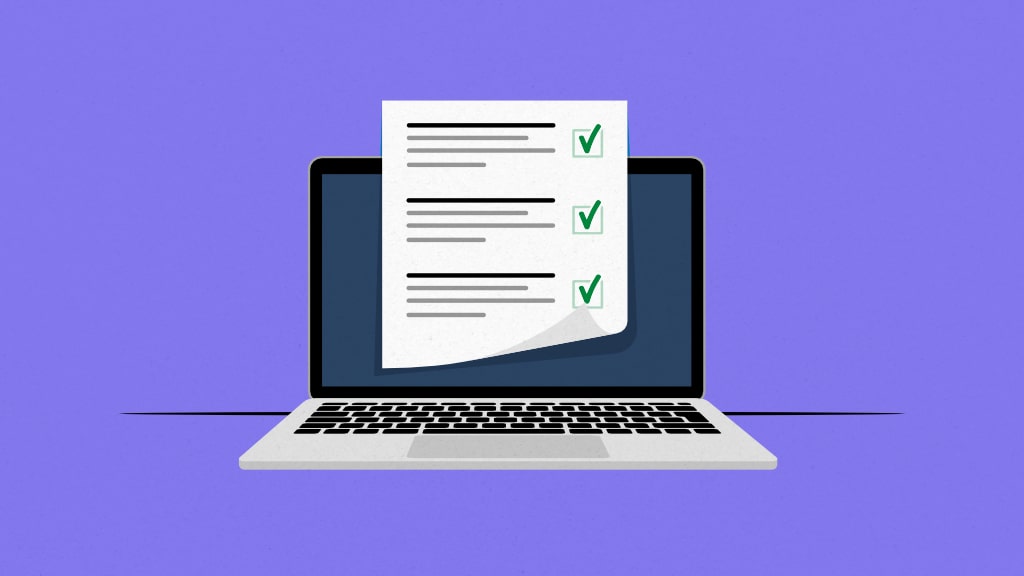Introduction
Every project has a primary objective: to produce some desired and meaningful outcomes. Those outcomes and results are defined as project deliverables. In my years of managing projects, I have seen the difference that well-defined deliverables can make.
I remember one project where the lack of clear deliverables caused months of miscommunication, extra work, and frustration among the team. It wasn’t that the team wasn’t producing high-quality work; we were. However, we are unsure if our efforts align with their vision without a shared understanding of all the stakeholders’ expectations.
That experience taught me a valuable lesson: the importance of starting every project with clear, agreed-upon deliverables. Since then, defining deliverables from the beginning has become my top priority, making a world of difference. This has helped align the team and given project stakeholders confidence that we all are working in the same direction to attain that goal.
In this post, I will discuss the essentials of project deliverables, their different types, their importance, and how to define and manage them effectively for success. At the end of this post, you will also learn how project management software like ProofHub can help you easily manage project deliverables.
What are project deliverables?
Project deliverables are the outcomes or results of a project. Every project is created to achieve some intended outcomes. These outcomes are defined before the project starts. A project manager focuses on achieving these defined outcomes of a project using project management tools and techniques. Therefore, it is vital for a manager to clearly define and understand the project deliverables and understand how to manage them.
Project deliverables include physical products, software applications, digital documents, reports, and guides. These deliverables can take many forms, but for an outcome to be qualified as a deliverable, it must produce results.
Difference between project deliverables and project milestones
Most people confuse project deliverables with project milestones, but both are different. A project milestone is a checkpoint that marks the progress of the project. It signifies a key stage or event of a project. A project deliverable is a tangible or intangible result from the client or internal project team. Completing a project deliverable may signify a milestone, but they are different terms.
For example, if you have completed 25% of the project but have not produced anything to show to the client. However, you still reached the milestone of completing the project by 25% based on the predefined calculations.
Read more: What is a milestone in project management and how to use it?
Difference between project deliverables and project objectives
Similarly, there is a difference between project deliverables and project objectives. Project objectives define what you want to achieve from a project. You may have delivered the intermediate project deliverables, but you might not have achieved the project objectives.
For example, you have created the log-in page of the mobile app and delivered it to the client for approval and feedback. But it does not mean you have fulfilled the project objective of this feature.
Read more: Project objectives: how to achieve them effectively
Types of project deliverables
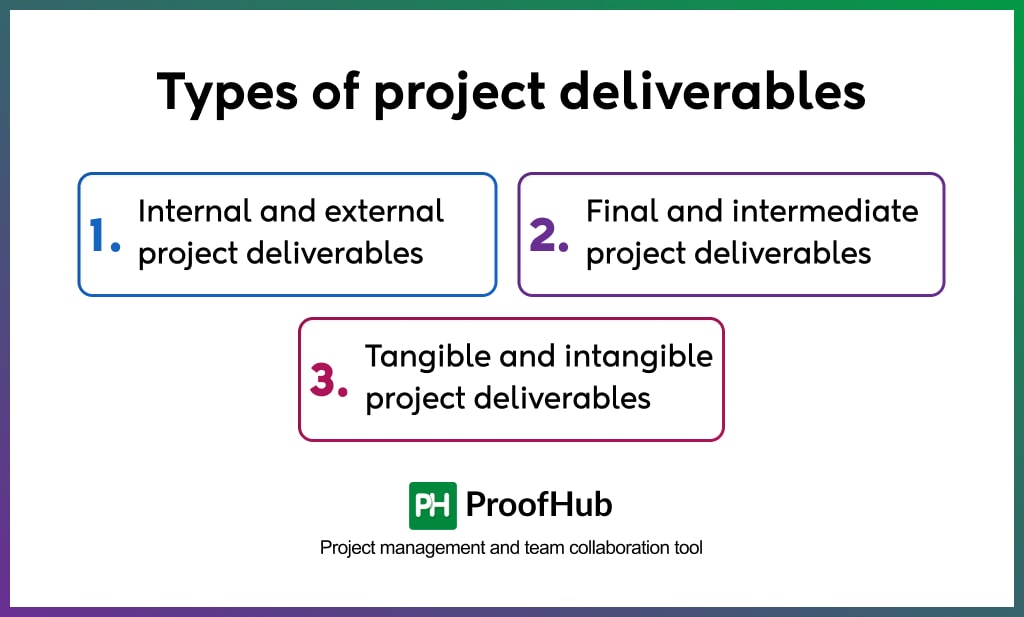
A project deliverable can take many forms. For enhanced understanding and easy classification of the project outcomes, experts have created multiple categories of project deliverables based on the use function.
Here are the three primary categories of the project deliverables:
- internal and external
- final and intermediate
- tangible and intangible
1. Internal and external project deliverables
Internal deliverables
These are created for the project team’s internal use and to keep the project on course. For example, an internal deliverable could be a project charter outlining a project scope statement, project report, etc. These deliverables lay a foundation for guiding the team and making decisions.
External deliverables
External deliverables are those that are shared with clients. Examples include initial design, final product, and project status reports.
2. Final and intermediate project deliverables
Final deliverables
The final deliverables are the outcomes of the project. Some people also refer to it as product deliverables. These deliverables mark the completion of the project. For example, a mobile application, a website, or a software.
Intermediate deliverables
Intermediate deliverables are the small deliverables that collectively make the project’s final deliverable. Some people also refer to it as process deliverables. These deliverables mark the reaching of the various milestones of the project. For example, a log-in feature of the mobile application.
3. Tangible and intangible project deliverables
Tangible deliverables
Tangible deliverables are the physical outcomes you can see, touch, and use. For example, a physical building of an office or a printed marketing material such as a brochure. Some refer to digital products as tangible deliverables, such as mobile applications.
Intangible deliverables
Intangible deliverables are products you cannot see, touch, and feel. For example, an increase in the brand awareness of a company as a result of a marketing campaign.
What are examples of project deliverables?
Project deliverables are outcomes of the project activities either used by teams to work on projects or delivered to the clients:
- Final products or services: The completed items delivered to clients or stakeholders
- Documentation: Reports, plans, and other materials created throughout the project for project team
To understand project deliverables better, let’s explore a few examples across different industries:
1. Website development project
Final deliverable: Fully functional, operational, and responsive website.
Intermediate deliverables:
- Website requirements document
- Project plan and work breakdown structure
- SEO and content plan
2. Marketing campaign project
Final deliverable: Executed marketing campaign with metrics and reports.
Intermediate deliverables:
- Market research report
- Content creation (social media posts, videos, blog articles).
- Campaign tracking and performance report
3. Software development project
Final deliverable: Deployed software application.
Intermediate deliverables:
- Software requirements specification document
- Alpha and Beta versions for testing
- User training materials and user manuals
Why are deliverables important in project management?
Project deliverables are much more critical than just defining what clients or stakeholders want to achieve from a project. Have a look at the few points explaining the importance of project deliverables.
1. Define scope
The most significant point highlighting the importance of project deliverables is defining the ‘scope’ of the project. This is because clients never define the project’s scope; they tell the business analyst and project owners what they expect from the project.
It is the role of the project owners and BA to understand the client’s expectations and translate and document them as project requirements, create a project scope out of it, define the project deliverables, and get approval from the client to begin the project.
In addition to that, project deliverables also play a key role in determining whether the project is beneficial or not to approach. It lays the foundation for the feasibility analysis of a project.
2. Create a checkpoint to measure the project progress
Each project is broken into small parts for easy management. Each small part or phase marks a milestone and usually creates a deliverable (internal or external). Thus, setting and defining the deliverables of the project helps you keep the project on track by measuring the project’s progress.
For example, you set the 25% of the project time and budget for creating a ‘log-in feature’ for a mobile app. It is your first small project deliverable. If you cannot deliver a log-in page within the allocated time and budget, your project risks delays and overruns. Thus, project deliverables generate a checkpoint to track progress.
Similarly, setting project deliverables for every milestone creates a roadmap and helps track the project’s progress to complete the project on time and within budget.
3. Keep everyone aligned
The key objective of writing project deliverables is to create a shared vision. Clearly defined and agreed-upon project deliverables keep everyone on the same path and create a shared understanding and vision of the project. This also helps ensure the team’s accountability by clarifying the roles, responsibilities, and expectations.
4. Resource optimization
Project deliverables set a clear goal for the project phase or milestones. This helps project managers manage, reschedule, and optimize resources accordingly to achieve project objectives. This enhanced clarity helps better manage workload and reschedule resources to prevent burnout.
5. Avoid conflicts with stakeholders
Project deliverables help in the easy management of the project stakeholders because they are approved and set by the stakeholders. This makes it easy to get features approved as the stakeholders define the acceptance criteria. This enhanced transparency and prior approvals help avoid conflicts as you have deliverables documented and signed off by the stakeholders.
How do you define project deliverables?
The success of a project relies on clearly defining the project deliverables. Here are some steps a project manager can follow to define the project deliverables clearly:
1. Understand stakeholders’ expectations
The first step in clearly defining project deliverables is to gather the requirements from the stakeholders, such as what they expect and their motivations. This helps you clearly understand the project goals and objectives, comprehensively define the project requirements, and determine the final and intermediate deliverables in the form of outcomes.
How to do it:
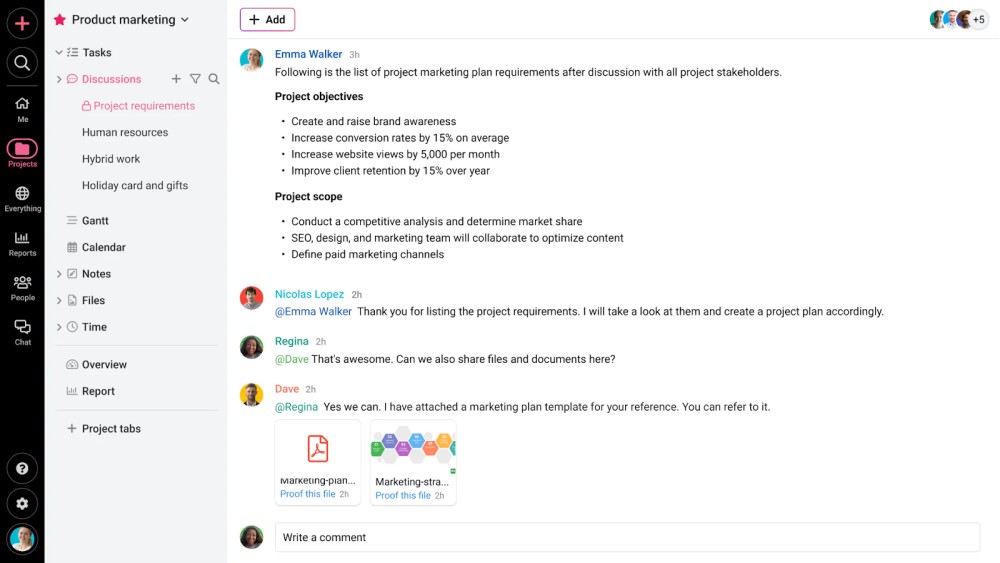
You can conduct brainstorming sessions with stakeholders to understand their expectations. Otherwise, you can demonstrate similar projects to understand expectations better and create a shared vision.
2. Break the project into small parts
Documenting what project sponsors want from a project will not help the project team. You need to define the project deliverables comprehensively by breaking significant deliverables into small parts.
How to do it:
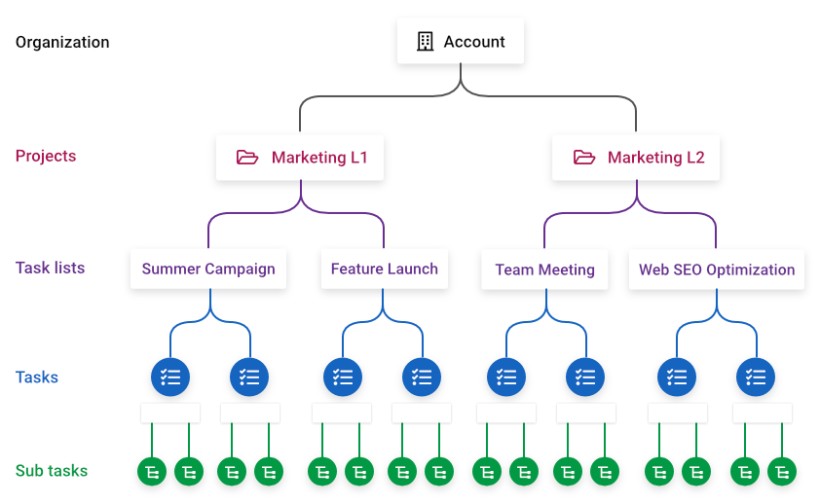
A work breakdown structure (WBS) is the best way to do this. It breaks the project into phases, tasks, and subtasks. This makes it easy to comprehensively define deliverables as they have broken down the significant goals into manageable goals.
3. Use the SMART framework
One of the biggest mistakes project managers make while writing project deliverables is not explaining the deliverables sufficiently. That’s why you will find that 37% of the projects fail due to poorly defined objectives. Thus, it would help if you defined the project deliverables clearly.
How to do it:
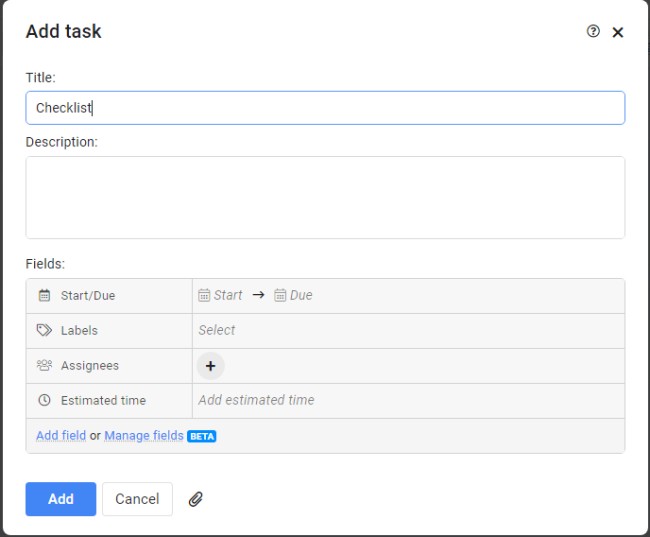
Use the SMART framework to define the project deliverables. SMART stands for Specific, Measurable, Achievable, Realistic, and Timebound. This will provide the context to the deliverables and make them tangible.
For example, rather than simply writing the project’s outcome in a single line, “I need a website.” Instead, explain what kind of website you need, what the purpose is, what pages you need, what the website’s goal is, and what objectives you want to achieve from the website.
4. Define the KPIs
Define quality standards and acceptance criteria for each deliverable. Do it before the project execution because it will help set the expectations for the project team. They will understand the work and quality requirements better.
How to do it:
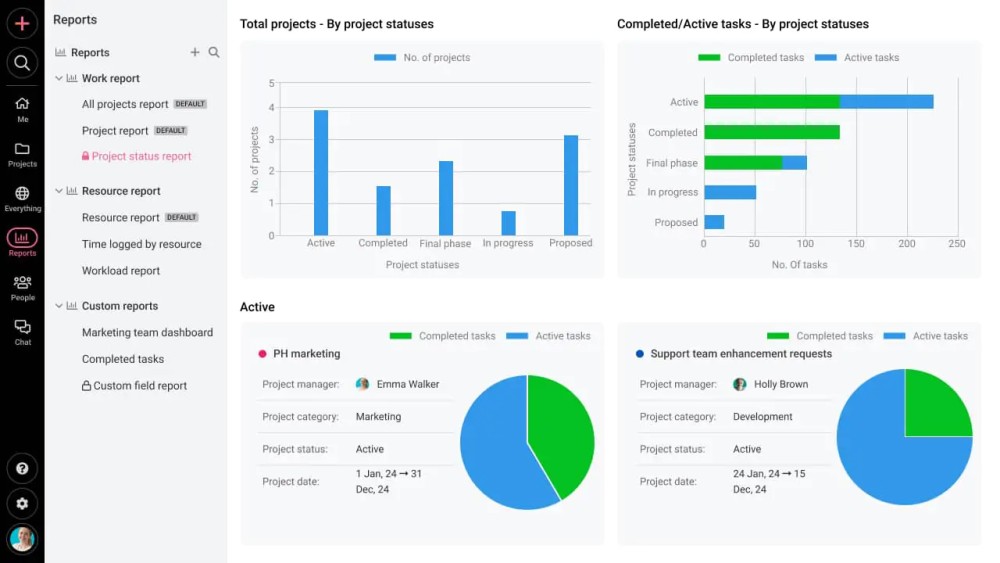
To make KPIs easy to understand, set measurable KPIs. For example, to accept the final software product, it must pass all user acceptance testing with at least a 95% success rate in bug-free operations.”
5. Document the stakeholders and owners
Ensure each deliverable has a clear owner or team responsible for its production. This ensures accountability and better workflow management. Specify who is responsible for each deliverable and key stakeholders needing to review or approve it.
How to do it:
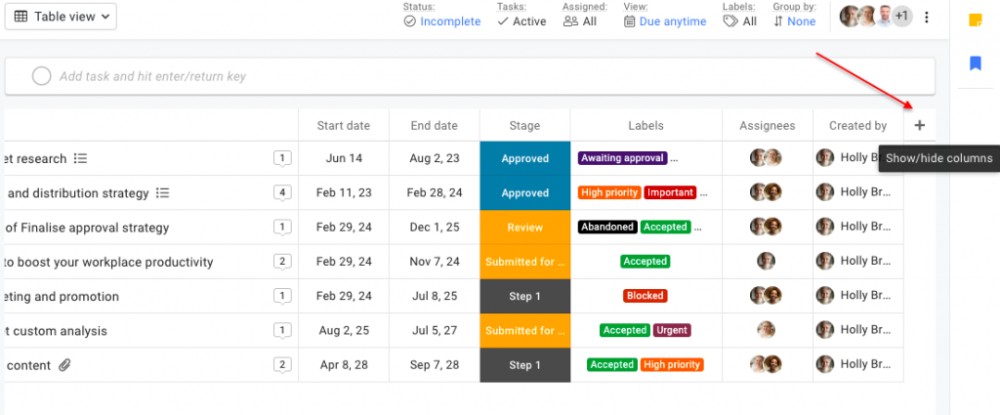
Use the RACI matrix to assign owners. A RACI matrix, or a RACI chart, is a project management tool to clarify project roles and responsibilities.
RACI stands for Responsible, Accountable, Consulted, and Informed.
RACI for a task defines who should be responsible, accountable, consulted, and informed.
How to manage project deliverables?
While clearly defining the project deliverables is just the first step, you need to manage the project deliverables actively. This is because some inevitable challenges are posed in every project. A project manager needs to actively manage the project to ensure the timely completion of the project deliverables.
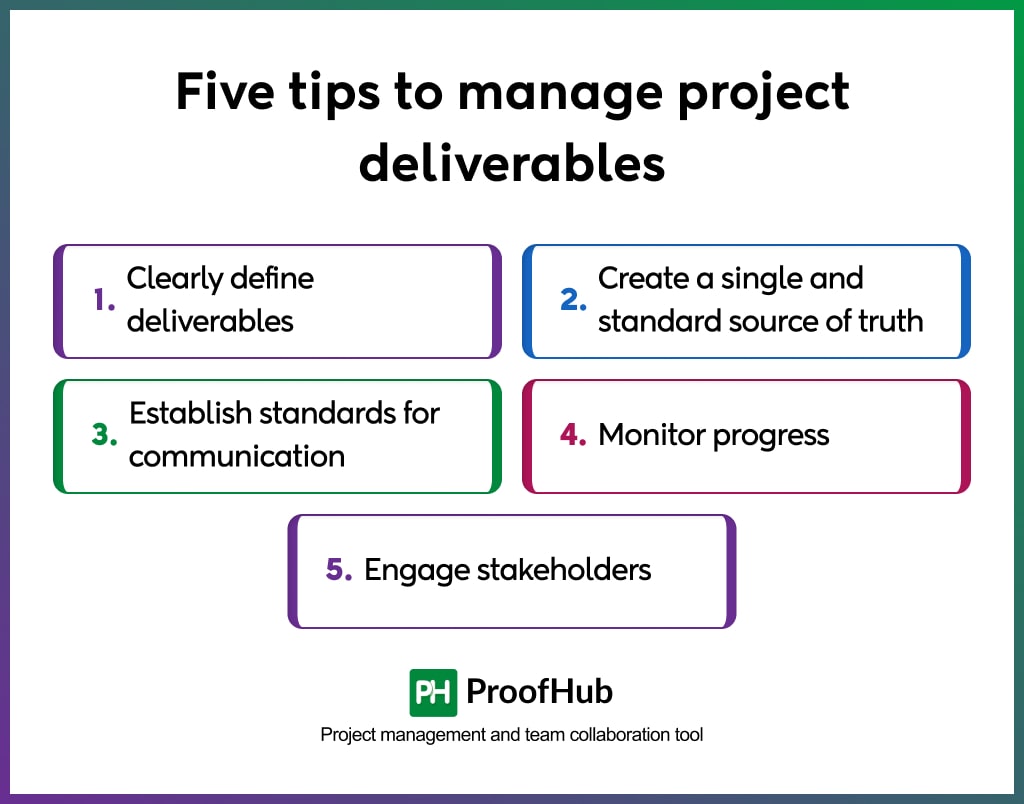
Here are five tips for managing project deliverables:
1. Clearly define deliverables
Clearly define the project deliverables to create a shared understanding of the project. To do so, break the significant project deliverables into smaller parts, use a work breakdown structure to define intermediate deliverables for each project phase, involve stakeholders in the discussions, and assign the owner for each deliverables to clearly define the roles and responsibilities.
2. Create a single and standard source of truth
Once you clearly define the scope of each deliverable, it is essential that everyone has access to the project deliverables and know how the project deliverables impact the project goals and success. This will help avoid misunderstanding and ensure accountability. You can use project management software to ensure everyone has the standard information. It enables you to set the project’s overarching goals for each phase.
3. Establish standards for communication
Working on the project deliverables is teamwork. Therefore, it is essential to have a standard set of communication guidelines and channels to ensure the project team works properly on the project deliverables. It also helps in the free flow of information and enables you to communicate the progress and updates of the project deliverables.
4. Monitor progress
To effectively manage the project deliverables, you must monitor the progress accurately. Track the project progress regularly and compare it against the project plan to identify the bottlenecks.
The best way to do so is to use a Gantt chart. A Gantt chart provides a baseline to track the project’s progress. Any deviation from the project is easily visible as soon as it happens, and you can evaluate the impact of the delay on the project timeline.
5. Engage stakeholders
If you want to manage the project deliverables successfully, involving stakeholders throughout the project is essential. There are two ways to do it:
- If project requirements are fixed and well-defined, stakeholders should be involved in the key milestones.
- If project requirements are unclear, involve stakeholders in developing every small deliverable.
This helps avoid reworking, better manage the scope creep, and better understand the stakeholders’ needs and expectations from the project.
To onboard stakeholders on the project, you can use project management software like ProofHub. It allows you to create a restricted account for the stakeholders or clients to engage in the project while you can manage permissions to hide the other information. Let’s find out how ProofHub can help you manage project deliverables.
Manage project deliverables using ProofHub
ProofHub is an all-in-one project management and team collaboration software that helps you manage project deliverables. It provides a comprehensive set of features to create projects, delegate tasks to the team members, and facilitate collaboration.
Here is how ProofHub can help:
- You can define and document project deliverables using project discussions to brainstorm with stakeholders and clients.
- Attach project deliverables to a project using shared files.
- Break project deliverables into small parts and add project deliverables at various key stages of a project using a Gantt chart.
- Create a shared understanding within a team with transparent and centralized task management.
- Provide restricted access to clients to engage with projects and approve deliverables.
Conclusion
Project deliverables play an essential role in a project’s success. They define the project scope, create checkpoints to keep the project on track, and keep all the project stakeholders on the same page. Managing project deliverables actively using the right tools, techniques, and skills is important for success.
Frequently asked questions
Which document should list and describe all of the deliverables required for the project?
Three key project documents list and describe all deliverables: Project charter, Project scope statement, and Work breakdown structure.
A project charter is a document that defines why a project has come into existence. It includes key deliverables and is usually the first document to be prepared for a project.
A project scope statement is created based on the project charter. It includes a list of the project’s final deliverables and a detailed explanation.
Work breakdown structure is a project planning tool and document that breaks a project into smaller tasks and defines its critical deliverables along with their key details such as deadline, owner, and description.
Who is responsible for completing project deliverables?
A project manager is responsible for completing project deliverables. Still, the manager needs the assistance of the project team, clients, and all the other stakeholders to complete project deliverables on time. This is because they play a direct role in achieving project deliverables.
Which section of the project management plan provides the planned cost of deliverables?
The cost management plan provides all the details related to the project’s cost. It outlines how costs will be estimated, budgeted, and controlled throughout the project lifecycle.
What is the difference between project requirements and deliverables?
Project requirements represent the detailed specifications of project deliverables and how they should be. It includes outlining criteria, features, and conditions that must be met for the project’s deliverables to be considered acceptable.
On the other hand, project deliverables represent the results that are tangible or intangible outputs produced as a result of completing project tasks and activities. They represent the outcomes that must be delivered to meet project objectives.
How often should project deliverables be reviewed and updated?
The frequency of reviewing and updating project deliverables can vary based on several factors, including the project’s complexity, duration, and stakeholder needs. Ideally, these reviews can be conducted weekly, bi-weekly, or monthly.
